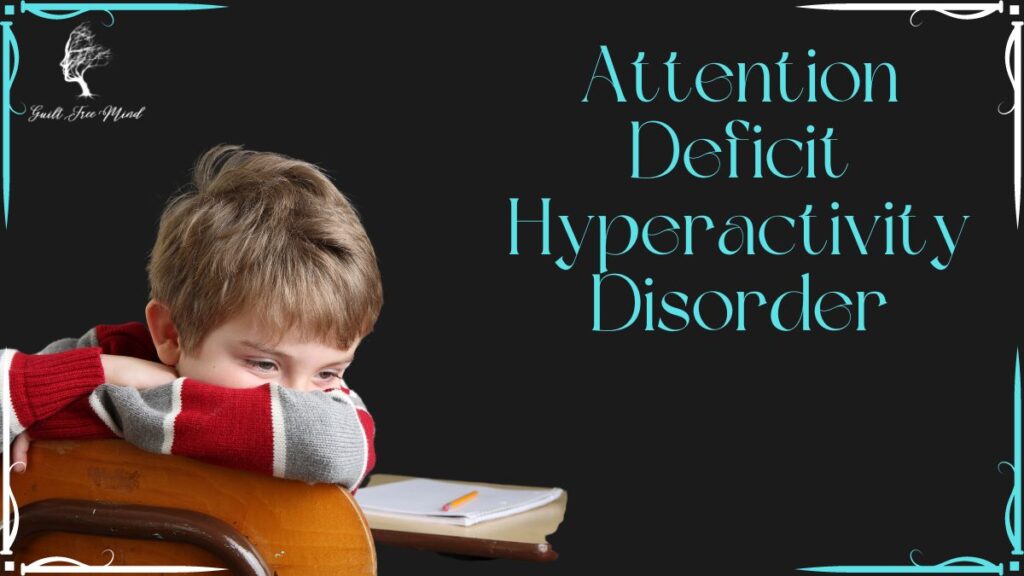Attention Deficit Hyperactivity Disorder or ADHD is one of the disorders that start during childhood and progress through the adulthood stages. The most common symptoms of ADHD involve inattention (unable to keep his or her focus on the task at hand), hyperactivity (need to move and constantly fidgeting. Basically, the inability to sit still for any length of time), and finally, impulsive behavior (acting in a hasty manner without any prior thought).
Table of Contents
Attention Deficit Hyperactivity Disorder
Attention Deficit Hyperactivity Disorder is a debilitating and chronic disorder. It has been known to impact the sufferer in multiple aspects, including professional and academic achievements, interpersonal relationships, and functioning on a day-to-day basis. Those who suffer from ADHD often also have poor self-esteem. If ADHD is left untreated, such individuals develop poor social function.
Adults suffering from ADHD may show reduced self-worth, increased self-criticism, high sensitivity towards criticism from others, and an inability to focus on the task at hand for long periods. The low self-worth may come from a lifetime of criticism, either from parents or peers. In most cases, the symptom of ADHD in kids and adults differ.
Statistics regarding Attention Deficit Hyperactivity Disorder
Attention Deficit Hyperactivity Disorder is one of the most common neurodevelopmental disorders to affect kids. It affects around 5% of the children population in the US alone. As per the American Psychiatric Association (APA), around 2.5% of the adult population also suffers from ADHD. Males are three times more likely to suffer from this disorder than females.
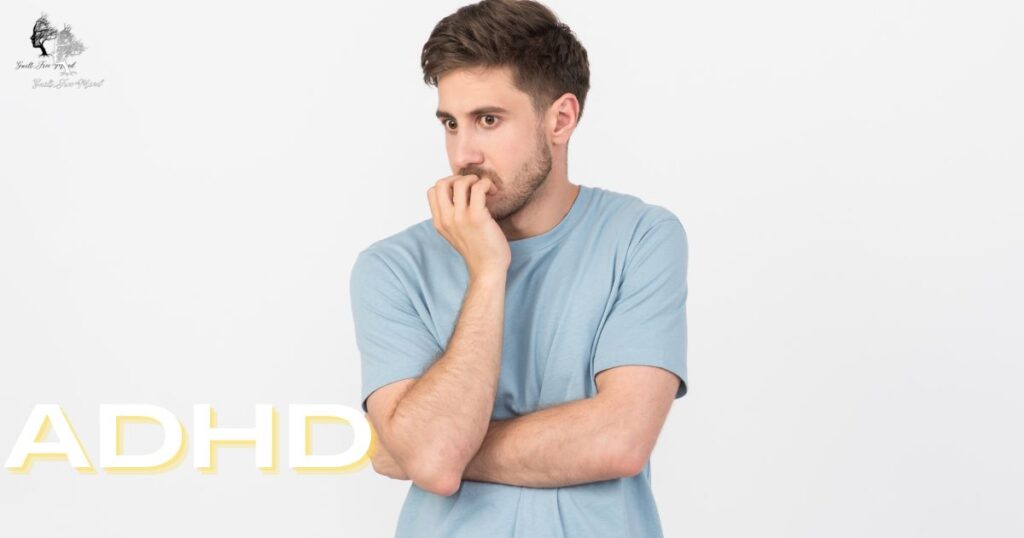
Adults and kids suffering from Attention Deficit Hyperactivity Disorder may face issues like hyperactivity, difficulty paying attention, and challenges with impulse control for long periods. If left untreated, it can disrupt the person’s ability to understand, process, or even learn information.
Identification of ADHD
Attention Deficit Hyperactivity Disorder is first identified in children of school age. This most often comes into account when the kids cannot focus on class. The teachers call up the parents and complain about their deficiency of attention. When the parents take their kids to a mental health practitioner, the diagnosis of ADHD comes through. Even in the case of kids, Attention Deficit Hyperactivity Disorder is more commonly present in boys than girls, given the differences in symptoms. However, this in no way means that girls do not have ADHD. In the case of males, the symptoms more commonly lean towards hyperactivity. They also show other external symptoms. While in the case of females, the most common symptom is inactivity.
Forms of Attention Deficit Hyperactivity Disorder
Attention Deficit Hyperactivity Disorder or ADHD manifests itself in three different forms. These three forms have been published in the diagnostic and statistical manual of mental disorders [DSM-5]. Let’s look at the three forms of ADHD before we progress with the causes behind ADHD.
Attention Deficit Hyperactivity Disorder form 1: predominantly hyperactive-impulsive
Whether kids or adults whosever suffers from this form of ADHD struggle with impulsiveness and hyperactivity. Most of the time, such people would show hyperactivity. They may also show inattentive behavior along with hyperactivity.
Two parts
There are two parts to this form of Attention Deficit Hyperactivity Disorder. One is hyperactivity, and the other is impulsiveness. Hyperactivity involves the person exhibiting constant motion. This may be talking constantly or fidgeting excessively. In the case of adults, you may see this behavior present itself in the form of exaggerated restlessness and a level of activity that others may find very tiring.
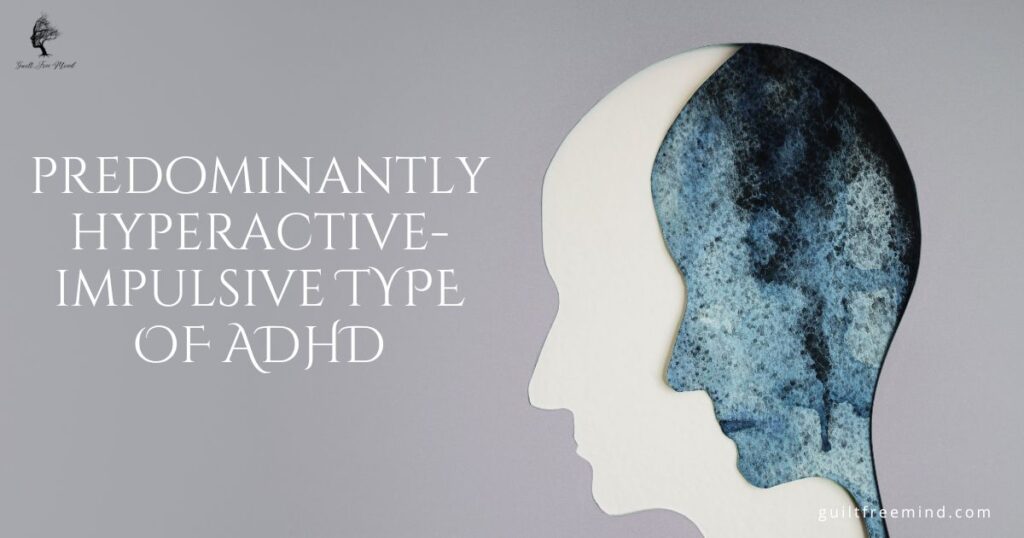
The other part of this form of ADHD is impulsivity. Impulsivity means that the person will form decisions and take action without thinking about the consequences. Even though there is a chance that the action may harm themselves or others, they will deep dive into it without even considering what the results might be. They don’t care whether the results are detrimental, long-lasting, or harmful. The need for impulsivity is the cause behind the person looking for instant gratification. If such people are in a social situation, their impulsivity forces them to interrupt an ongoing discussion and present their point. Such people may also show extreme levels of impatience and get angry or frustrated quickly.
Signs that you have a hyperactive or impulsive type of Attention Deficit Hyperactivity Disorder
To be positively diagnosed with this form of ADHD, you have to check five or six of the following symptoms on a recurrent basis. You also must be either 17 years old or older.
- Inability to stay quietly seated, whether in a classroom or in the workplace.
- Constantly fidgeting, squirming in the seat, or tapping hands or feet.
- Tendency to climb or run about in locations where it is inappropriate.
- Unable to indulge or engage in any leisure activity in a quiet manner.
- Constantly on the go and have a need to move as if controlled by a motor.
- A habit of constantly talking too much
- Tendency to blurt out the answers even before the question has been completed. For example, finishing other people’s sentences, blurting out in the midst of conversations, talking even before someone else’s sentence has finished, etcetera.
- Finding it extremely hard and challenging to wait in line for their turn.
- Have a habit of constantly intruding or interrupting others’ sentences. For example, such people may cut into other’s games, activities, or conversations. They may also start using others’ stuff without asking them. Older adults and teens may take over tasks of others and not even complete them.
Attention Deficit Hyperactivity Disorder form 2: Predominantly inattentive
If you suffer from this form of Attention Deficit Hyperactivity Disorder, your primary problem will be inattentiveness. Such people also have periods of impulsiveness and hyperactivity. However, hyperactivity and impulsivity are not crucial in the case of this ADHD form. This form is also referred to as attention deficit disorder or ADD.
How do you define inattentiveness?
Inattentiveness is the inability of a person to stay focused on one task. If someone is easily distracted from the task that they are doing and consistently lacks organization and persistence, it is a sign that they are inattentive. This form of ADHD can lead to personal and professional difficulties because of the person’s inability to pay attention to the details of the task. Such people also find it very hard to meet deadlines, board meetings or attend social functions on time.
Common symptoms of the inattentive type of Attention Deficit Hyperactivity Disorder
For the diagnosis of this type of Attention Deficit Hyperactivity Disorder, the person must either be 17 years or older. They must also show positive results for either five or six of the following symptoms occurring repeatedly.
- Find it very difficult to pay attention to details or makes a lot of silly mistakes in job and school tasks.
- Constantly facing problems in staying focused on any activity or task. Inattentiveness during lectures. Long reading or maintaining a conversation is also hard for such people due to their shifting focus.
- Does not seem to be tuned in or even remotely attentive when being spoken to (seems to be in another world or absent-minded).
- Does not follow up on priorly given instructions. Does not complete any kind of schoolwork, job duties, or chores (starts the task but loses focus and forgets about the task completely in a while).
- Highly disorganized. Finds it impossible to stay organized on the work and tasks. They find it hard to manage time for the work at all. This leads to disorganized add messy work. Such people most often miss the deadline of the work they have been given.
- Any task that requires the person to provide a sustained mental effort is something these people will avoid. For example, if you ask such people to complete a form or prepare reports, they will hate it.
- They tend to lose common things that are required for their day-to-day activities. For example, such people easily lose their books, eyeglasses, cell phone, wallet, keys, and school papers.
- Easily distracted
- They even tend to forget their daily chores and tasks like putting things in the right places. In the case of adults and teens, they may forget to pay the bills, return any phone calls or even keep appointments that have been priorly scheduled.
Attention Deficit Hyperactivity Disorder form 3: combined hyperactive, impulsive, and inattentive
This is the form of Attention Deficit Hyperactivity Disorder that contains all three characteristics of ADHD. Such people are not only hyperactive and impulsive, but they are also inattentive. This form is most often observed in the case of children. However, if the study is done amongst preschool children, you will notice that the most common symptom is hyperactivity.

Signs of combined ADHD
These patients will show signs from both the above-mentioned ADHD forms.
How to identify combined ADHD in kids?
Children with hyperactive tendencies tend to constantly fidget, squirm, talk excessively and find it very hard to sit still in one place. Impulsivity can express itself as disruptiveness, impatience, and difficulty waiting for their turn to speak or to engage in an activity. Inattentiveness shows up as difficulty in following the instructions given by the teacher, daydreaming, difficulty in focusing on the activities in the classroom, and finally showing signs of forgetfulness in day-to-day activities.
Adults with this form of Attention Deficit Hyperactivity Disorder show:
- Impulsiveness
- restless behavior
- difficulty in concentrating
- a habit of frequently interrupting others
- absence of organizational behavior
- difficulty in following through with a task
- inability to meet deadlines,
- regular mood swings
- impossible to cope with their day-to-day stress
Diagnosis of Attention Deficit Hyperactivity Disorder
If you observe ten preschool children in a room, you will notice that nine of them have difficulties sitting still. Does this mean that all nine of them suffer from Attention Deficit Hyperactivity Disorder? No. Most kids of preschool age find it difficult to sit still, wait for their turn, pay attention to the teacher, etcetera. They act impulsively and are extremely fidgety. However, this does not mean that they suffer from ADHD.
Kids who meet the criteria of ADHD in the DSM-5 manual show a difference in their hyperactivity, organizational skills, impulsivity, and inability to pay attention. ADHD kids display such behavior at a higher rate than normal kids. Thus, these problems cause them to suffer at home, at school, in relationships, and at work.
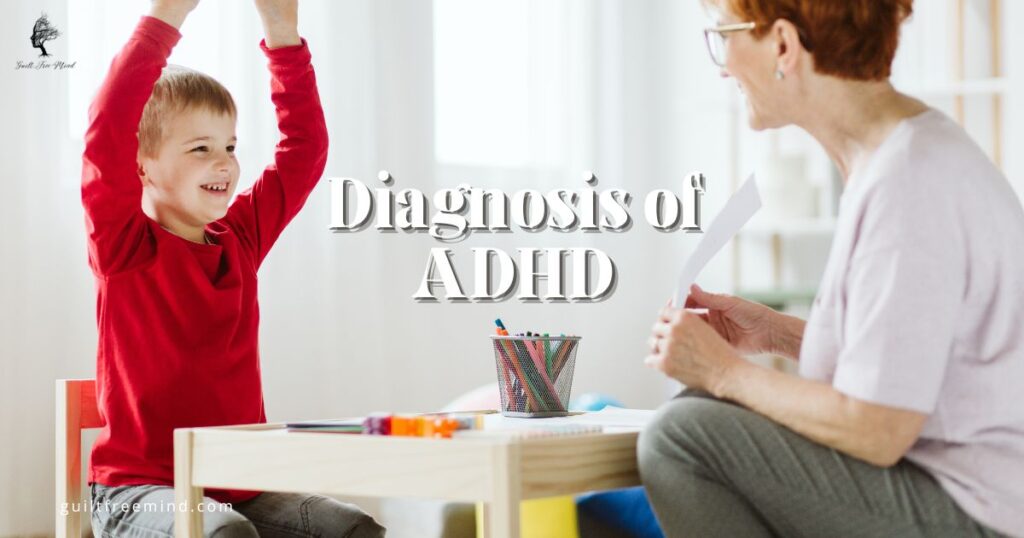
Unfortunately, many times parents think that the child is being defiant and irritable and does not want to study. However, if your child is repeatedly displaying symptoms of learning disabilities, you should take your kid to the psychologist as soon as possible. These symptoms are not the result of the child trying to be defiant. These occur because the child is unable to understand the task at hand.
The diagnosis is made by professionals.
Attention Deficit Hyperactivity Disorder is diagnosed by either a primary care provider or a mental health practitioner. When you go to the mental health practitioner, they will ask you to give a complete description of your or your child’s symptoms. They will also ask questions relating to the disease.
You will be given different questionnaires to fill out. For kids, these questionnaires will have to be filled out by the caregivers and teachers. Furthermore, the practitioner will require you to provide family history, medical history, psychiatric evaluation, as well as information regarding upbringing, the environment, and education. Finally, complete detail of the medical evaluation will be needed to rule out any underlying medical condition that may be causing the symptom.
Similarities of ADHD with other mental health disorders
There are several other mental health conditions that show symptoms that are close to ADHD, like mood disorders, substance abuse, anxiety, learning disorders, thyroid conditions, head injury etcetera. In case the person has an oppositional defiant disorder, learning disorder, anxiety disorder, or conduct disorder, the person may also exhibit ADHD along with it. Therefore, before diagnosis, a complete and thorough psychiatric evaluation is conducted. Unfortunately, at the moment, there are no routine imaging tests or blood tests to identify ADHD in the patient. Sometimes, the patients may be asked to undergo further psychological tests like psychoeducational or neurophysiological testing. They may also undergo a computer-based evaluation to understand the severity of the symptoms.
Causes behind Attention Deficit Hyperactivity Disorder
The specific ADHD cause has not yet been identified. There is a ton of evidence that suggests that ADHD could probably be a manifestation of genetics.
Genetic causes behind ADHD
The one proof that indicates that ADHD may be dependent on genetics is the fact that the relatives of those suffering from ADHD are also affected. There have been several genes identified that have been linked to ADHD. However, no specific gene or combination of genes has been identified that can be labeled as the root cause of ADHD in a person.
Neurochemical causes
There are certain anatomical differences in the brain of a person affected with ADHD compared to a normal person. For example, kids with ADHD show reduced levels of white and grey matter volume. They also have activation of certain brain regions that may be different from normal when performing specific tasks.
Other studies have indicated that the caudate nucleus, cerebellar vermis, and frontal lobes of the brain are also affected in the case of ADHD.
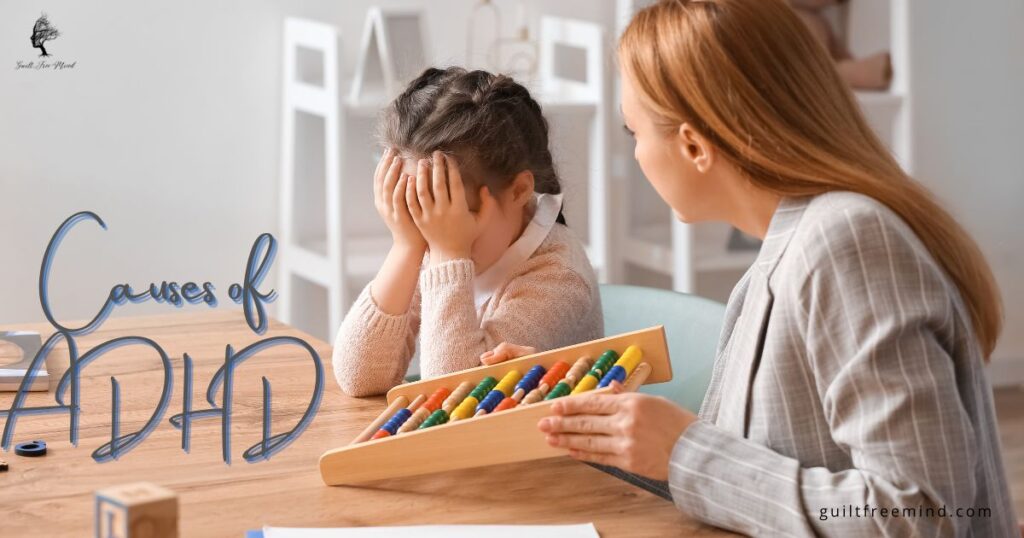
Non-genetic factors contributing to ADHD
The non-genetic factors that have shown to have a role in ADHD are
- Premature birth
- Low birth weight
- Exposure to toxins during pregnancy like lead, cigarettes, alcohol, etc.
- Suffering from extreme stress during pregnancy
Treatment of Attention Deficit Hyperactivity Disorder
In most cases, the treatment of ADHD involves a combination of medicinal prevention and therapy. In kids involved in preschool, the first line of approach includes parent management training as well as school intervention. For kids, normally, parent-child interaction therapy is used. This is an evidence-based therapy that has been used with kids who suffer from oppositional defiant disorder and ADHD.
ADHD medicines
As per the latest guidelines, psychostimulants like methylphenidate and amphetamines are the first line of treatment for managing the symptoms of ADHD. For kids and preschoolers suffering from ADHD, amphetamine is the only FDA approved medication. However, it has been observed that if the behavioral interventions seem to be ineffective, methylphenidate might be a more promising drug.
The alpha agonists like guanfacine and Clonidine, along with atomoxetine (selective norepinephrine reuptake inhibitor), are the other options that are FDA approved for the treatment of ADHD.
The latest list of FDA-approved medications includes:
- Methylphenidate in an extended-release form: This medicine is normally taken at night. The medication starts to show effect by the next morning.
- Dextroamphetamine: this is an amphetamine patch
- Viloxazine: non stimulant
- Methyl phenate hydrochloride
- Amphetamine extended-release oral suspension
- Mixed salt amphetamine product
- Methylphenidate extended-release orally disintegrating tablets.
The ADHD medication depends on the practitioner, the symptoms that the patient is showing, the tolerability of the medication, and the treatment efficacy. Many times, if the medicine seems to be ineffective, the medical practitioner may change the administered compound. It takes a while for the psychiatrist to find out the exact medicine and the dose that is effective for the patient. The meds improve the symptoms of ADHD and restore normal functioning at school, work, and home.

How can the school help with ADHD in children?
School staff and teachers have a crucial role in providing the parents of the child and the doctor with the information that can help them evaluate the behavior and understand if the child is truly suffering from ADHD. The school staff is also responsible for helping the child with learning problems and behavioral training. Since school staff has not been certified, they cannot diagnose the child with ADHD, make any decision about the treatment or ask the student to specifically take medicine before attending school. These decisions are only in the hands of the guardians and parents, who are responsible for the primary health care of the child.
ADHD in adulthood
Many kids continue to suffer from ADHD even well into adulthood. Sometimes, kids realize that they have ADHD only after entering the adulthood stages. If the child had a DHD but did not get proper medical intervention, chances are that the symptoms of ADHD would increase by the time the child grows into an adult. Adults with ADHD may not realize that they have a disorder in the first place.
Most often, the evaluation by the mental health practitioner will include a complete review of the past and the current symptoms. Along with this, a complete medical exam, history, and different checklists and scales will be used to identify if the patient is suffering from ADHD. For adult ADHD, the option of treatment includes psychotherapy or medication, or a combination of both. There are many self-care strategies. These can help reduce procrastination, distraction and increase the organizational capability of the person. However, a person suffering from ADHD also does need support from their immediate family to successfully battle the disease.
Conclusion
Unfortunately, ADHD is a mental health disorder that has no treatment. However, the symptoms are managed with proper medication and self-help strategies. If you are someone suffering from ADHD, you should look into self-help options along with your treatment. Your treatment will help you bring the symptoms under control, but the self-help options will make you truly efficient in your work and personal life.
Attention Deficit Hyperactivity Disorder is an extremely debilitating disease if it’s allowed to get out of hand. Therefore, quick action is the best way to go. If you feel that you may be exhibiting symptoms of ADHD, there is no harm in going to a psychologist. No one will prescribe you medication without conducting a battery of tests. Consult a mental health practitioner as soon as possible and find out if you truly have ADHD or not. You can either then go for self-help options, or you can start taking medication to help with the focus.
Wanna know more?
If you want to know more about ADHD, the causes, the statistics, the effect of ADHD on interpersonal relationships, etcetera, please subscribe to Guilt Free Mind. The subscription option is present in the sidebar. Your subscription will allow me to notify you the moment a new blog post is released. This way, you will stay up to date with the latest tips and tricks in the mental health industry. If you like watching videos, please subscribe to the YouTube channel of Guilt Free Mind. In case you have any queries about this blog post or any other, feel free to reach out to me on any of my social media channels. If you want a live conversation, you can find me on Twitch. I host coworking sessions on Twitch six days a week from 10:00 AM to 7:00 PM IST.
Are you looking to beat ADHD? The first step to beating such a disorder is reducing procrastination. Coworking streams can help with distractions and allow you to become organized in your daily life. Check out my coworking stream on Twitch. It might be of help to you.
Share your experiences
Do you have ADHD? How do you deal with the symptoms on a regular basis? When was your ADHD diagnosed? What medication are you on? Do the medications help? Please mention your experiences in the comment section below. Your comment may encourage someone else to reach out for the help that they deserve. ADHD is a serious mental health condition. It is time that we destigmatize mental health conditions and make this world a better place for everyone.
See you in my next blog post
